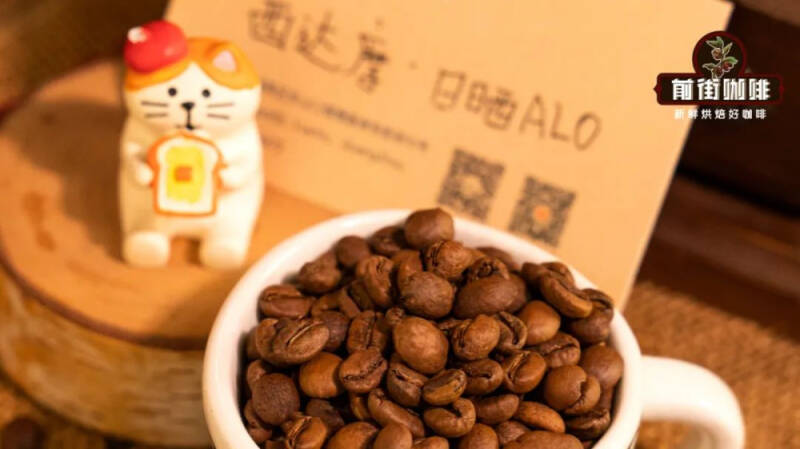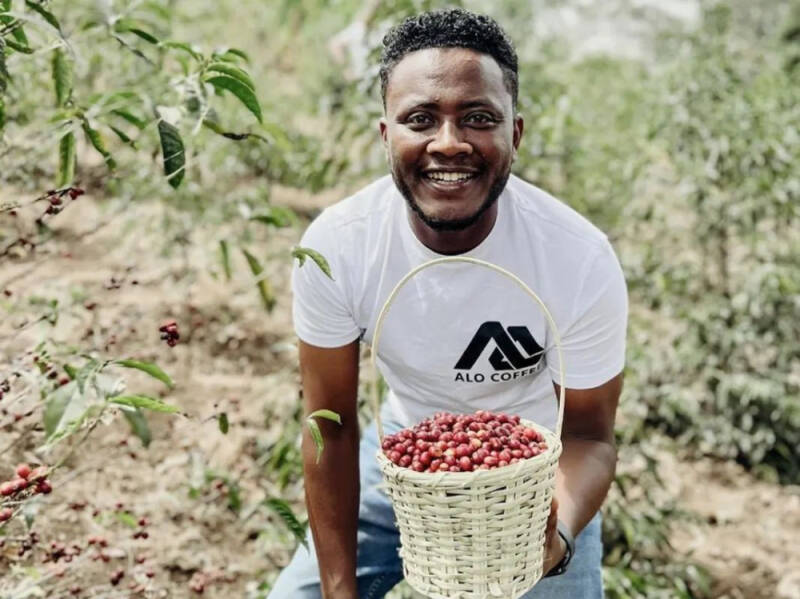Introduction to Alo Village, Sidama Sidamobansa Town: What does Alo coffee mean?

Front street coffee: Essex Sidamo Alo Hatessa sun-dried coffee beans country: Ethiopia production area: Sidamo Bansa Alo Hatessa altitude: 2180-2280m Variety: 74158 Grade: G1 treatment: tanning method
Flavor: Magnolia, passion fruit, pineapple, mango, fermented feeling
What does Alo stand for?
Alo Coffee PLC Coffee is a coffee trading company from Ethiopia, founded in 2020, mainly responsible for exporting coffee from Bensa producing areas, so it is also equivalent to a raw bean brand.

Its founder, Tamiru Tadesse Tesema, took part in the 2021 COE contest with beans grown and processed in the village of Alo Village in the second year of the company, and won first place (anaerobic solarization 74165) and fifth place (solarization 74158). From then on, Alo Coffee and Alo village began to rise to fame in the entire coffee circle and broke into the eyes of countless enthusiasts.
Where is the village of Alo?
According to the map, Alo Village is located in the northeast of the Sidamo producing area, on the highest slope of the town of Bensa Woreda. The Bansha area is famous for its unique geographical advantages, growing from 1800 meters to 2300 meters above sea level. Compared with many classic representatives of Ethiopia, many coffee trees in Bansha town grow between 2200 and 2,350 meters above sea level, and the famous village of Alo is the best among them, up to 2400 meters above sea level.
Qianjie also mentioned in previous articles that for fine coffee, the higher the altitude is, the slower the coffee fruit will grow, and the harvest time after maturity will be later than that in other places, so the raw beans will have a higher density. the aroma structure will be more complex and rich. On the other hand, because of the high altitude, the drying time of coffee fruit will also be prolonged, and the fermentation process after picking will be relatively low, so it will give rise to a fuller "flower and fruit aroma".
The man behind Alo Coffee
Born and raised in the village of Alo, Tamiru majored in engineering, taught at university for two years after graduation and has been engaged in the boutique coffee industry ever since. In 2020, when he saw a grower friend who was also from Bansha Town winning the COE award, he realized that the fine coffee produced in this land had great potential, but it was difficult to produce in the market because of its small scale and backward farmers' conditions. He was determined to promote the high-quality "Bansha flavor" to the world, so he set up his own company, Alo Coffee.
Tamiru was first admitted to Q-grader, and then with his understanding of the cultivation and production of Banza coffee in his hometown, as well as years of experience in raw bean export trade, he began to sort out the production, marketing and quality of this region from zero, and also analyzed the difficulties and opportunities faced by Ethiopian boutique coffee. In just two years, Tamiru has made Alo appear frequently in many boutique cafes overseas.
In the same year that he founded the brand, he set up a raw bean processing station in Alo village to collect and process coffee cherries grown by more than 200 small farmers around them, provide them with professional knowledge training and technical support, and strictly control every detail of bean processing to ensure traceability of each link. Tamiru is also a caring person in his life. He spends part of his company's income on building schools to provide better educational conditions for local children.
Qianjie believes that the reason why Alo Coffee can achieve such a good reputation today, first of all, it is inseparable from Tamiru's 100% enthusiasm for his hometown Bansa, and secondly, it is due to his dedication to high-quality coffee and strict control over the quality of raw beans.
Understand the production footprint of Alo Coffee
At present, Alo Coffee's harvesting business is mainly concentrated in the area of Bansha Town under the Sidamo production area. if you distinguish by village, in addition to the best-known Alo village, there are batches from Bombe Village, Murago Village, Bashiro Gute (belonging to Bona zuria town) and other villages on the market, which are more than 20 minutes' drive from each other.
With regard to the information about processing stations, Tamiru has also made relevant disclosure on the official website. At present, the raw bean processing area under Alo Coffee includes Main (main processing station), Chilaka, Morke, Hatessa, Mewa, Hurro, Gute, Chire Kalo and other eight processing stations.
Qianjie query information learned that the main processing stations Main, Hatessa and Chilaka are located in Bensa,Morke is located in Bura,Mewa and Hurro are in Nensebo,Gute in Bona Zuria. All processing stations will be located near the coffee farm in order to carry out post-processing work faster, as well as to ensure the freshness of coffee cherries.
In Ethiopia, since many processing stations (washing and processing plants) are mainly responsible for picking coffee fruits from the surrounding area, the stations are usually named directly after the village. For example, resident contestants Kochere and Banko Gotiti on the Qianjie bean list are named after their villages. Similarly, Hatessa, Mewa and Gute not only represent a village, but also refer to the name of a washing station.
In terms of planting varieties, most of the coffee produced by Alo are 74 varieties of JARC (Jemma Agricultural Research Center), including 74158, 74165, 74112, 74110, etc., such as winning the COE championship in 21 years is 74165, but at present, only 74158 of Alo is relatively common on the market. The batch for Qianjie is 74158, selected from Alo Coffee's Hatessa processing plant (shown as "Hatesa" on Google Maps), a small village 23 kilometers south of Alo village, where coffee fruits are traditionally tanned.
Sun treatment
Before the formal sun drying, the farmers first pick the fully ripe fresh coffee fruit by hand, deliver it to the Hatessa processing station, conduct the first round of screening, and then reclassify the fruit before washing, by observing the skin color to remove the over-ripe or undermature fresh fruit to ensure that the color is uniform before the sun.
For sun-cured coffee, the farmer in charge of post-processing needs to turn the fruit on the tanning bed very diligently in the first three days, because the coffee cherry at this time has a high water content, and it is not only easy to grow mildew if it is not turned in time. And it will also lead to unpleasant sour or rotten fruit flavor due to uneven heating. Throughout the process, the fresh coffee fruit is only covered with a thin layer in order to give them a better ventilated and dry environment. After 14-18 days, the moisture content is reduced to the target level and can be bagged and sent to the warehouse.
Qianjie observed that most of the raw beans in Hatessa sun batches were small, with round and mini particles, and the number of eyes was about 10 to 12. For this bean, Qianjie wants to highlight the sweetness of its ripe fruit while retaining its more floral aroma. Qianjie chose medium-shallow baking to show the elegance and tonality of this Alo.
Through the cup test, Qianjie first felt the sweet flower and fruit aroma of this Alo, the dry aroma has obvious characteristics of magnolia, pineapple, yellow peach, small awn and other characteristics, accompanied by sweet fermentation aroma, very good smell.
When sipping, the mouth is full of sweet and sour tropical fruits, such as ripe pineapple, passion fruit, perfume lemon and other flavors, accompanied by a hint of black tea, and a gentle sense of fermentation combined with the smell of light flowers. As the temperature drops slightly, coffee begins to tend to stone fruit characteristics such as yellow peach and dried apricot, and the acid is clear and bright without losing its hierarchy, which is very special.
-END-
Important Notice :
前街咖啡 FrontStreet Coffee has moved to new addredd:
FrontStreet Coffee Address: 315,Donghua East Road,GuangZhou
Tel:020 38364473
- Prev

It's fierce! Naixue's tea is changed to open a Chinese restaurant?!
▲ Click to pay attention| Daily Boutique Coffee Culture Magazine Coffee Workshop Recently, a netizen posted that he had seen a Chinese menu in Naixue Tea House located in Guangzhou. Judging from the photos posted by the customer, the meals sold in this store include both exquisite morning tea and refreshments, as well as some local specialties. mentioning
- Next

Lucky's new product is actually a "water-mixed raw coconut latte"?!
▲ Click to pay attention| The Daily Boutique Coffee Culture Magazine Coffee Workshop mentions Ruixing Coffee, and many people will associate it with the raw coconut latte that helped it get out of its trough. Since its launch in 2021, this drink has captured the hearts of many coconut heads and has become one of Lucky's signature products. Based on this, every time the raw coconut series is updated, lucky
Related
- Being chased out of the rain in front of Starbucks?! Store: Sheltering from rain under umbrellas poses a safety hazard
- The white moonlight has changed?! Lucky launches "Big Winter Pear American"
- Hand-brewed coffee three-stage method, high-sweet and universal brewing method to share! What does the high sweet water level of hand-brewed coffee mean?
- What is the difference between raw, refined and full espresso coffee? How to extract espresso and taste good?
- A complete list of coffee bean names and their meanings! What is Yejia Shefi coffee? Where is Mantelin coffee?
- What grade does Arida Manor Kaduai coffee beans belong to? What treatment is Arida ASD slow anaerobic sun exposure?
- The milk tea cup becomes smaller?! Overlord Tea Girl launches a new "Return to Yunnan" series
- Accused of selling counterfeit and high-priced coffee beans! Well-known boutique coffee brand "Oukelao" bowed and apologized!
- How to make espresso dumplings? Can I eat coffee and glutinous rice balls together?
- Save the unformed and stagnant powder cakes in one second! What is the problem with stagnant water in the powder bowl of the espresso machine?

